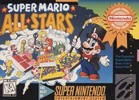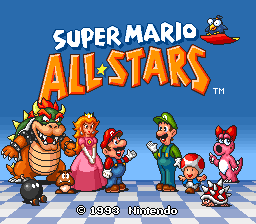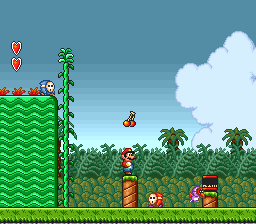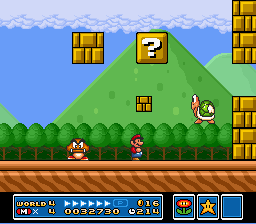Forum Links
Thread Information
Creator
04-04-15 12:05 PM
Post
04-05-15 04:33 PM
9.3
Today: 1
Users: 0 unique
Thread Actions
Super Mario All-Star: the Mitigated Transition to the Next Level
04-04-15 12:05 PM
janus is Offline
| ID: 1154032 | 1803 Words
SecureYourCodeDavid
POSTS: 678/4811
POST EXP: 565163
LVL EXP: 22897515
CP: 63616.5
VIZ: 553003

Probably following the mid-1990s fashion or remixing old things and putting a modern twist to them, Nintendo decided to resuscitate all of Mario’s games from the NES (including the “real” Super Mario Bros. 2, which was renamed “The Lost Levels” ) and show a new generation of gamers how the fat Italian plumber’s (original) adventures originate from. While the graphics are very beautiful and the platform function allows you to save and quit, I felt like the games had lost their original charm by moving from 8-bits to 16-bits. Graphics: 9/10 The graphics in all four games are undeniably a stellar improvement from their NES counterparts. It’s especially obvious for Super Mario Bros. 1/The Lost Levels. Mario, Luigi, Toad and Princess Toadstool now all have human proportions instead of being blobs of pixels (the Toads you save even have different movements when you save them). The Marios’ coverall and shirt are now clear and their colors are now more distinguishable. They even have human-like eyes and faces. Furthermore, the levels have been greatly improved with very rich backgrounds everywhere that goes from daylight to night time. Even Bowser’s castle (that includes thunder outside) was improved. Speaking of Bowser, he even looks better than in Super Mario World since you can see him all, and even see him burn in the lava. As for TLL, the wind blowing looks more realistic. Super Mario Bros. 2 has also gotten very nice improvements. The slight pixel excess from the characters is now gone, the backgrounds are more colorful everywhere (including underground) and the slot machine is now easier to manipulate. Movement such as picking up and throwing is also more fluid and Birdo is now better-drawn (he/she even has a cute buckle on the head and the head has more realistic proportions). Finally, I have mixed feelings regarding Super Mario Bros. 3. Sure, the levels are all more colorful, and so are the Marios and all the monsters. However, I believe that the overworld maps are too colorful. Sure, it used 16-bits technology correctly but for those like me who played the original game, it just looks too much. The original design was simpler and better. Music: 5/10 This was my biggest disappointment about the game. The 16-bits face lift just didn’t carry most of the charm from the original games (I'm an "originalist", what can I say). The Mario 1 overworld remix was probably the largest disappointment. I mean, this is probably the best-known theme of all times – or at least up to the 16-bits era. The SNES version just doesn’t have the same whistling proneness (the Super Mario RPG version sounded better) and the end-of-level fanfare is overdone. However, the castle music did sound more dramatic, and the underwater theme sounded more soothing. The Mario 2 overworld theme was closer to the original one, but its 16-bits lift made it slower and less interesting than its NES edition. The other themes (underground, boss) sound about the same. However, the final boss theme is much better. Finally, Mario 3 also has its hosts of disappointment. The overworld themes for worlds 1 (overdone), 2 (the “Arabic” tones were too much), 5 (the SNES synth made the theme worse) and 8 (not dramatic enough) were better on the NES, as with most levels (themes from 1-1, 1-2, the Mushroom House, in the clouds, the Boom-Boom fortress and his theme and the Hammer Brothers). However, worlds 3 (especially that one) and 4 did profit from a facelift by sounding more modern and less synthesized, whereas world 7’s synthesized beat sounds better on the SNES (world 6 sounds just about the same). The underwater theme also sounds more… magical, just like Mario 1 and the airship music also sounds half as good (the intro drum is more dramatic but the bursting trumpets sound too weird). Finally, while it did sound better in Mario 1, the generic underground theme from SMAS sounds inferior to the Mario 3 version. Now, with respect to sound effects, they’ve all been standardized for all games. They’ve basically been copied from Super Mario World, which was a good thing. The jumping sound is much less annoying on the SNES, the picking up sound is more realistic as are the canon sound (although strangely, it’s the same sound for door-opening) and the spitting sound. However, I found the jump-on-foe sound annoying; it’s as if you were trying to destroy a brick every single time, no matter what you jump on (a Goomba or a Troopa). Addictiveness: 8/10 With so many games before you, you’ll get hooked on to them for sure if you have at least some interest for the genre. The platform setting, where you can save after each world (each level for TLL) and get to keep the lives you get was a big plus. At last, you don’t have to restart the whole game every time you turn off your system, nor would you need to replenish your bonus item bank in Mario 3. You can even accumulate a few lives/items before moving forward with the levels, which is nice too. That way you can have as many music boxes to make the Hammer Bros. Getting to save after each level on TLL was a welcome addition. Considering the difficulty level (see below), it allowed you to save your course more meticulously. Plus it encouraged you to go from 1-1 through 8-4 without going for the warps, which gave you access to the secret world and prolonged your quest by about 16 levels. Finally, despite some exaggerations (see above), the 16-bits graphics are really appealing to the eye and strengthen the playability. They are even more colorful than Mario World (without being psychedelic) but also more varied. Depth: 8/10 Since the games are copy/paste versions of their NES versions, the depth of the game varies greatly. Mario 1, having been published in 1985, shows its lack of depth. Despite having eight worlds, they don’t have much to explore. They do have a few bonuses and secret passages leading to warp zones (you can access the eighth world in a jiffy), but they otherwise are very linear. Plus, most castles are carbon copies of each other; higher levels simply have more obstacles like rotating fireballs. TLL, on its side, does show a little more depth. Levels are larger and have many more obstacles. However, just like Mario 1, the levels are either above ground, in the air, underground on in the water. That all changes in Mario 2. While still rather linear, at least Mario 2 regularly alternates between over and underground, bringing some variety. There are also many hidden keys/bombs to be found in order to progress, meaning you will have to go down all those urns in order to find them. Finally, Mario 3 is HUGE. Although you don’t have to complete all levels to complete each world, you will still have to complete most of them in order to move to the next world. Each level is very diversified, with all sorts of different obstacles to face making all levels quite different from each other. By collecting a specific amount of coins you can even yield a N-Spade card giving you free goodies, a Hammer Bros. boat full of coins or even a Secret Mushroom House giving you a P-Wing (in odd worlds) or an anchor (in even worlds except 8). Difficulty: 7/10 Once again, the difficulty level varies greatly from game to game. The first few levels in Mario 1 are fairly easy. Once you get a flower, your fireballs can basically kill anything in sight. However, past world 5 many enemies become immune to get like cannon balls and some black-shelled enemies, for which you will need to be careful. Also, Hammer Bros. tend to pop up out of nowhere in later worlds too, so be careful. Finally, some castles have very specific paths you need to take. Otherwise, you will either go back to the beginning or walk in an infinite loop (fortunately, SMAS has sounds to tell you if you took the right path). Oh, and not being able to move left past a certain point is annoying; I like to explore levels thoroughly. TLL is one of the most difficult games ever produced in the 8-bits era. To quote tasvideos.org, it’s an exercise in fake difficulty: most long jumps can only be successful if you time them right (by jumping on one or more enemies in succession in order to advance), there are HUGE gaps at times that you go across thanks to strong winds, so timing is also essential. Finally, occasional poisonous mushrooms will shrink/kill you if you touch them. Mario 2 has a reasonable difficulty level. Unlike Mario 1, you can increase your life bar with mushrooms so you don’t instantly shrink when you get hit. Plus, since you can choose among Mario, Luigi, Toad and Princess Toadstool, all of whom have strengths and weaknesses, you can always switch characters should you die. Finally, invincibility stars are much easier to come by; you just have to pick enough cherries, which are hanging everywhere. And you can freeze the enemies for a few seconds by picking up enough mature vegetables. Mario 3 is the most (reasonably) challenging of them all. All levels have different obstacles to go around, including piranha plants that spit fire, flying turtles that can move left and right and mad suns (and ghosts) that fly right at you. There are auto-scroll levels that will prove to be challenging, especially in the Ice World – slipped a few times in bottomless pits. Most of them however are in the end-of-the-world castles, which will also prove to be challenging. In the early levels, you will have to watch for cannon balls. But as the worlds progress, you will also have to look for fire cannons, the risk of being squeezed by the screen, gaps (some of which you must go over by jumping on slippery screws) and wrench-throwing enemies that never really die. Finally, the Boom-Boom fortresses have sometimes many passages that will confuse you. Oh, and Boom-Boom sometimes flies around, so watch out. In short, despite an uneasy translation to 16 bits, Super Mario All-Star is a must-try for people who think 8-bits graphics are too primitive. All four games are a copy/paste version of their 8-bits counterpart so you won’t miss an ounce of the original games. The platform feature will allow you to save the game for later (and even accumulate a few lives/items on the way) and let all the family play – those with siblings might remember that Shining Force II only had TWO slots… |
YouTube Video Editor
| the unknown |
Affected by 'Laziness Syndrome'
Registered: 12-14-12
Location: Murica
Last Post: 17 days
Last Active: 1 day
04-05-15 04:33 PM
gamerforlifeforever is Offline
| ID: 1154650 | 70 Words
gamerforlifeforever2

POSTS: 920/10715
POST EXP: 585502
LVL EXP: 77412457
CP: 104688.2
VIZ: 3585305

I think you did a very nice job making this review. I've never actually played Super Mario All-Stars before, and after reading this review, I think I may try it out some time. It's disappointing that the music doesn't live up to the standards of the originals, though soon I'll get to see for myself how bad it really is. Overall I think you did a very good job though. |
| Ultimate Pokemon Fanboy, Member of the Year 2016, and Vizzed's #1 My Hero Academia fan |
Affected by 'Laziness Syndrome'
Registered: 07-04-12
Location: Somewhere in Ohio
Last Post: 86 days
Last Active: 82 days


 User Notice
User Notice 






